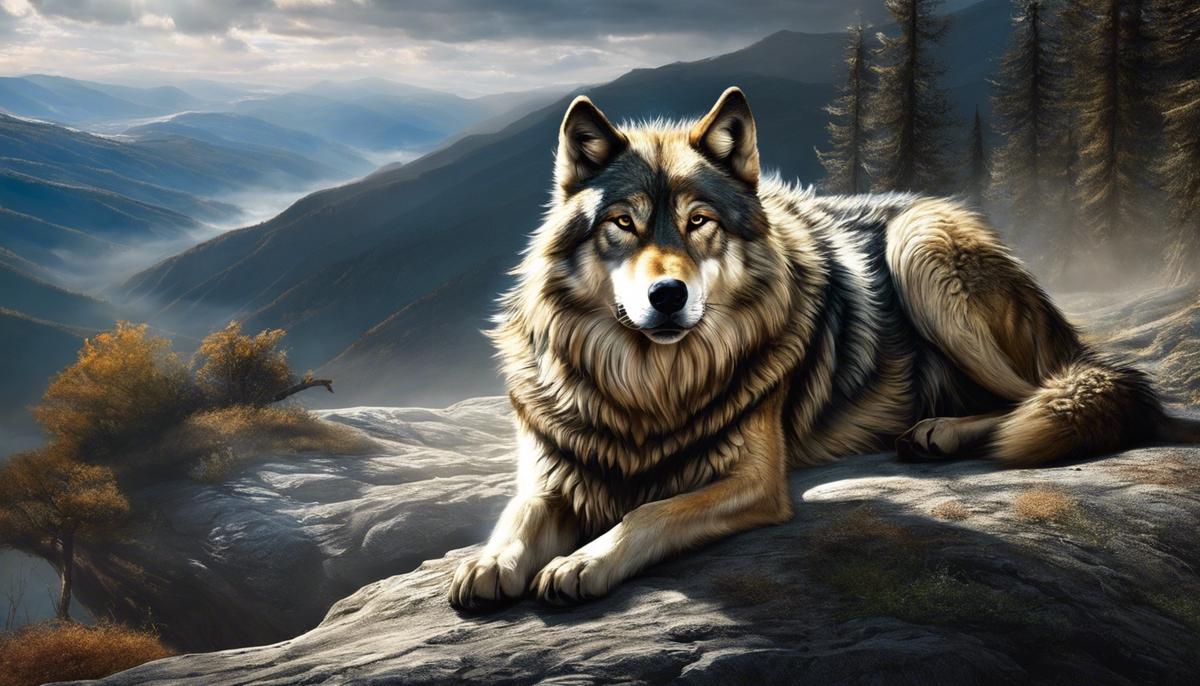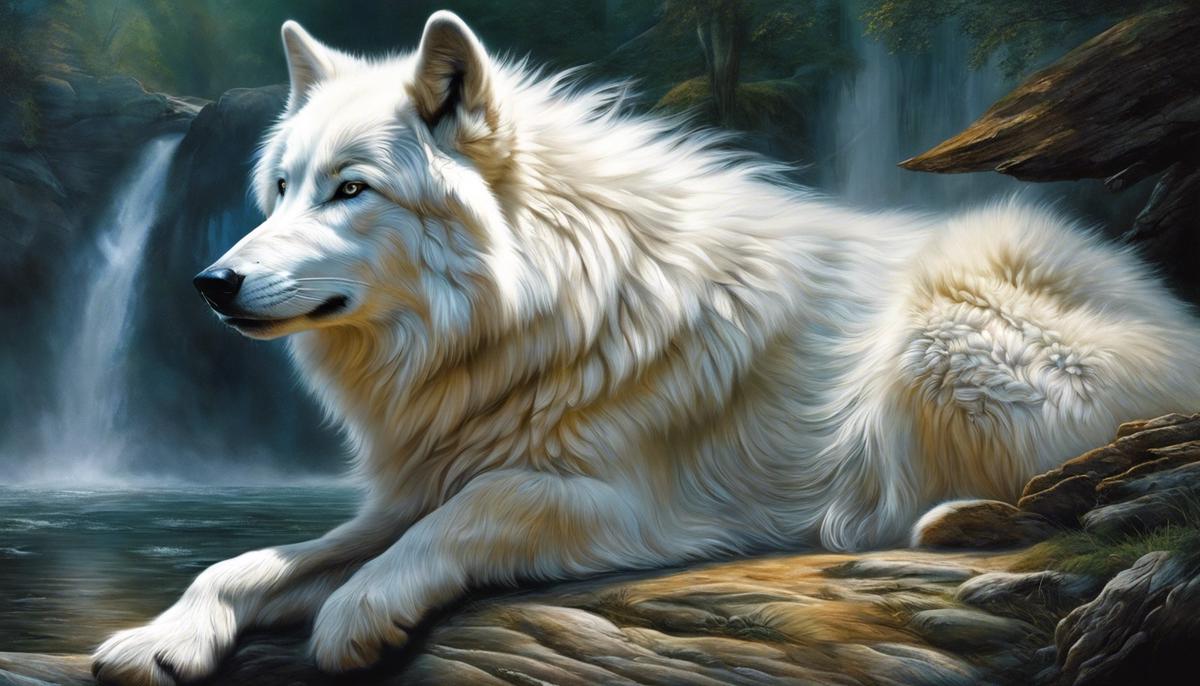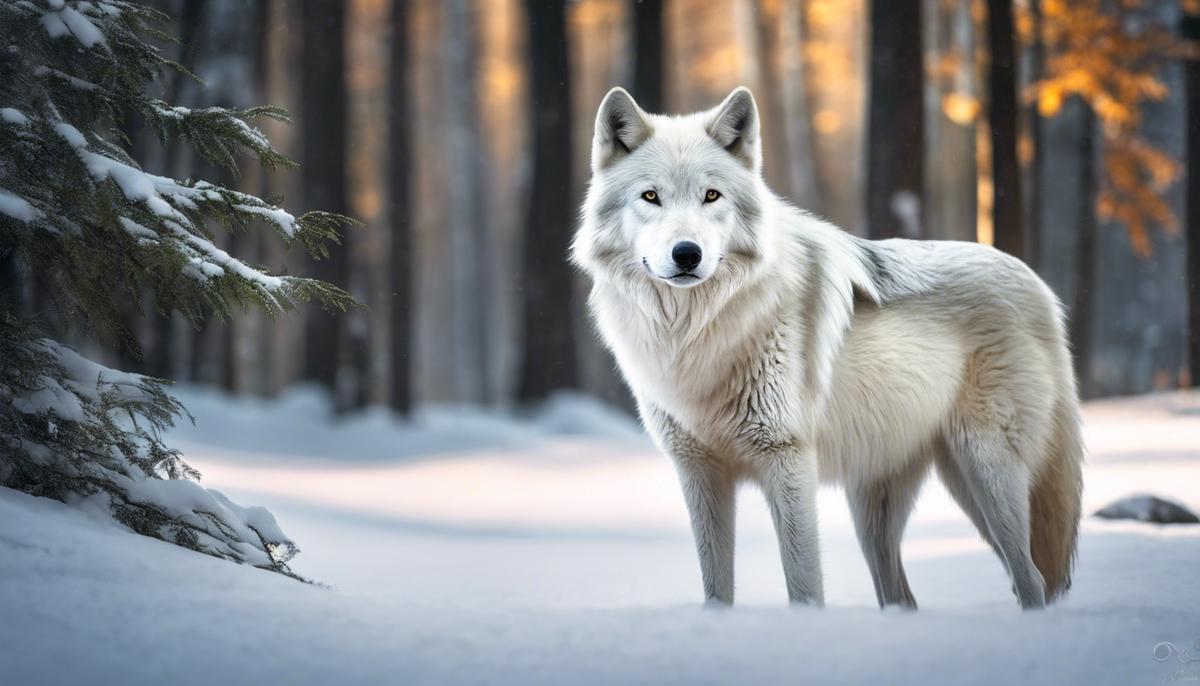Wolves, awe-inspiring creatures of raw power and undeniable mystery, have long captivated the human imagination, their presence woven into the fabric of our cultural and spiritual consciousness. Notably present in the narrative landscape of the Bible, wolves emerge as symbols teeming with inspirations for parables and teachings. These interpretations, however, often reveal paradoxical, dual notions of danger and deception. When the prism of dream symbolism projects these wolf attributes onto the canvas of human psyches, an intriguing tapestry of meaning unfurls. Layered into this already complex emblematic language is the color white – a symbol of purity, righteousness, and divinity in biblical contexts and beyond. The complex interplay of these elements manifests in the dream symbol of the white wolf—an enigma inviting exploration.
Historical references to wolves in biblical texts
Title: The Symbolic Representation of Wolves in Biblical Texts: An Examination
Throughout historical and cultural contexts, animals have been employed as potent symbols. As stewards of the Earth’s biodiversity, we are endowed with the responsibility to comprehend these representations and understand the relationship between humans and the natural world. Among these symbolic animals, the wolf, a creature revered and feared in equal measure, is featured significantly in biblical texts. This piece delves into the specific manner and interpretation of the wolf’s symbolic representation in such texts.
The Bible paints a melodrama featuring the wolf as a creature of dichotomy. This dichotomy manifests in descriptions of its predatory behavior contrasted with moments of peaceful coexistence with other species. These binary characteristics offer insights into the cultural and philosophical mindset of the people in ancient times, especially how they perceived unpredictable and potentially threatening forces.
Isaiah 11:6-9 provides a vivid image of the wolf in a state of serenity and harmony, living side by side with the lamb during the prophesied reign of the ‘Prince of Peace’. This passage has often been interpreted as a promise of a future era wherein natural enemies will no longer fear each other, embodying universal peace and harmony. The wolf, here, serves as an emblem of transformation, reconciliation, and the balancing of inherent oppositions.
Contrarily, in other texts such as Matthew 7:15, the wolf symbolizes deceit and danger. The verse warns of ‘wolves in sheep’s clothing’, false prophets who appear gentle and benign but carry destructive intentions. This adept metaphor accentuates the wolf’s predatory instincts and stealth, emphasizing caution and vigilance in the face of deceptive appearances.
Yet another symbolic shade emerges in the parable of the lost sheep, where the shepherd leaves his flock unprotected to seek the one stray sheep, leaving the rest in danger of being devoured by wolves. The wolf, in this context, is viewed as a symbol of the perils that lurk when the protector is absent, heightening the idea of vulnerability and the need for vigilant protection.
In biblical anthropology, these symbolisms derive from observed and inferred behavior of wolves. The compassionate regard for wolves seen in some contexts might stem from a respectful acknowledgment of the animal’s survival skills and pack community dynamics. Similarly, the depiction as stealthy predators can be traced back to their hunting methods and natural tendencies.
The recurring motif of the wolf in biblical texts underlines the nuanced understanding of this creature, highlighting core themes of transformation, deception, and vulnerability that resonate well beyond the confines of these texts. The wolf’s biblical depiction offers a profound prism through which we can explore the embrace of natural variables in constructing human narratives about peril and redemption, deception and sincerity, conflict and harmony. Through such a symbolic lens, one can observe how societies mirror and personify their understanding of the natural world into their cultural, spiritual, and moral constructs.

Meaning of the color white in biblical and dream symbolism
The Color White in Biblical and Dream Symbolism: An Exploration
To delve deeper into biblical and dream symbolism, it is essential to cast the spotlight on the color white, a hue that evokes feelings of purity, innocence, and cleansing. Interestingly, these undertones are not restricted to modern interpretations but are deeply entrenched in ancient symbolism and biblical narratives.
Throughout biblical scripture, the color white blazes a trail of purity and righteousness. Derived from the Greek word ‘leukos’, the symbolism of white spreads throughout the New Testament, embodying purity, light, and triumph. A prime example is found in Revelation 3:5 where the victorious are promised to be arrayed in white garments – an indication of purity and spiritual victory. Moreover, in The Book of Daniel 7:9, white takes on an aspect of divinity as it depicts the Ancient of Days – God, donning a white garment, thus associating the color white with the divine and the eternal.
However, the exploration of white in scripture is incomplete without discussing the ‘white stone’. Mentioned in Revelation 2:17, the ‘white stone’ has been a subject of various scholarly interpretations. While many view it as a symbol of acquittal from guilt, others perceive it as admission into heavenly bliss. Regardless, it is consistent with the overarching thematic attributes of white – innocence, victory, and spiritual inclusivity.
Leaping from biblical texts to the realm of dreams, the color white retains its symbolic potency. In the world of dream interpretation or oneirocriticism, colors play a pivotal role in understanding the subconscious. Similar to biblical symbolism, dreaming of white often conveys feelings of purity, innocence, and freshness. This can manifest in varied forms – a white room indicating a fresh start, white flowers suggesting purity of intention or a white animal representing instincts purified through wisdom.
Yet, the prism of dream symbolism is multidimensional; colors also embody potential warnings or revelations about the self. Thus, too much white could symbolize feelings of isolation, emptiness, or the fear of new beginnings due to its association with the starkness or emptiness of a blank canvas.
Furthermore, a vital perspective in dream symbolism comes from legendary psychoanalyst, Carl Jung, who believed colors held universal symbolism but were also incredibly subjective, dependent on the dreamer’s personal associations and experiences. Therefore, for some individuals, white may embody peace, while for others, it may suggest sterility or coldness.
In conclusion, the color white in biblical and dream symbolism is a versatile entity, rich in interpretation. It predominantly speaks of purity, innocence, and victory but is also a symbolic chameleon, adapting to the narrative’s context and to individual perception. Subsequently, understanding its implications allows one to better appreciate the profound layers of both scripture and subconscious visions. Undeniably, such multilayered symbolism can provide unique insights into societal, psychological, and spiritual aspects of human life. Just like the playful interplay of colors in a piece of art, the rich tapestry of symbolism weaves in dimension into the human understanding of the world, and the color white paints a significant part of this grand narrative.

Integration of white wolves in dream symbolism
Now that we have established the multifaceted symbol of the wolf and the color white individually in biblical texts, let’s delve into their intersection in dream interpretations. Dream interpretation, a practice with roots in ancient Egypt and Greece, is occasionally viewed with skepticism today; however, its potential for psychological insight remains coveted among professionals in health and mental care.
In dreams, wolves typically embody raw emotion and instinctive survival mechanisms appealing to the ‘wild’ or ‘primitive’ and unfettered within us. But a white wolf carries additional connotations fortified by the layers of meaning accompanying the color white.
In a dreamscape, the symbolic confluence of a white wolf introduces a duality, an internal conflict of positive and negative traits. It introduces an embodiment of survival instincts coupled with concepts of purity and righteousness. As in biblical texts, where white represents purity, righteousness, and divinity, a white wolf in dreams sprinkles a divine touch, invoking an almost spiritual ambiance over these raw facets.
These appearances might reflect a struggle or reconciliation between basal instincts and spiritual ideals within the dreamer. Such dreams may also represent individuals walking the line between visceral reactions and poised judgment. It may indicate a subconscious attempt to integrate qualities traditionally seen as ‘wild’ or ‘primitive’ with socially endorsed forms of ‘purification’.
However, the presence of too much white could symbolize an overburdening pursuit of purity and righteousness, possibly leading the dreamer toward alienation or bouts of perfectionism. Another perspective provided by Carl Jung was that color symbolism is highly subjective, influenced by personal associations, cultural context, and individual psychology. Therefore, the interpretation of a white wolf may be as much individual as it is collective.
Drawing upon Jung’s contribution, personal emotions, experiences, and cultural backgrounds significantly influence dream symbolism. What a white wolf represents in one dream could significantly differ from another individual’s dream, reflecting personal associations with the wolf motif and the color white.
In conclusion, the presence of a white wolf in dreams implies more than just a simple blending of wolf and white symbols. It presents a convoluted image that tests the human approach to survival instinct, spirituality, and an ongoing struggle toward purification. As this inviting realm continues to bewilder the human mind, scientific research endeavors to unmask the latent meanings that reside within it, in a quest for self-understanding and knowledge. As for the white wolf, its spectral presence in our dreams continues to pose profound questions about the essence of our humanity, beckoning us towards introspection and an increased understanding of our inner psyche.

Case studies on white wolves appearing in dreams
Biblical interpretation of dreams, particularly those involving white wolves, harbors the potential to uncover a rich tapestry of symbolism steeped in a mix of spirituality and psychology. Modern deciphering of such dreams defies blanket interpretations, demanding personalized attention, deeply reflective consideration, and a broad understanding of individual, cultural, and universal symbols.
Case studies present an enlightening approach for a practical understanding of such complex dreams. They illuminate the applicability of lofty concepts through real-world, tangible contexts. Examining a few examples opens doors to both clarity and deeper contemplation, revealing the profound significance of a white wolf’s appearance in dreams.
A compelling example emerges from a case study involving a middle-aged woman wrestling with moral dilemmas in her work environment. Her dreams involved a white wolf that served as a beacon of purity and righteousness within a dark wilderness, highlighting the struggle between her inner values and external pressure.
Conversely, another case study detailed a young man’s dream revolving around a white wolf. For him, the animal represented a symbol of wild, primitive instincts masked by an external layer of societal-approved morality, reflecting his internal conflict about fitting into societal norms.
Yet another fascinating case study concerns a military veteran plagued by dreams of a white wolf, symbolizing raw emotion and primordial survival instincts clothed in the purity of divinity. Here, the white wolf served as a reminder of a past riddled with survival-oriented decisions and the desire for redemption.
These case studies expose the duality and internal conflict that the white wolf can symbolize—an intertwining of the untamed and innate instincts with purity and righteousness. However, they also underline caution: each person’s unique experiences, emotions, and personality will color their dream symbolism and interpretation.
In this context, the negative interpretations attached to too much white in dreams surface as well, signaling an unhealthy overemphasis on purity and righteousness. An overbearing white wolf might signal suppressed emotions or instincts beneath a mask of pretended innocence or purity, indicating a potential for internal dissonance.
Although attempting to categorize dream symbols into strict interpretations is fallacious given the personal and subjective nature of dreams, broad themes do persist. The color white and the wolf as symbols hold definite indicators within dream interpretation, blending meanings from biblical, psychological, and cultural perspectives.
However, the realm of dream interpretation doesn’t preclude questions. Indeed, it stokes them, leading us down the introspection path. Such symbols invite us to delve deeper, encouraging us toward self-understanding and realization.
In essence, the appearance of the white wolf in one’s dreams offers a journey — a journey toward exploring the depth of the human psyche, our fear, our hopes, and our potential. While it may seem labyrinthine, it’s a labyrinth promising growth and a better understanding of our internal worlds. Like an onion, each layer exists to be unraveled, leading to the core, and on this pursuit, the white wolf serves as an enigmatic, yet enlightening guide.

As our exploration of white wolfs in dreams winds to a close, it becomes evident that this multifaceted symbol, as nebulous as it is intriguing, continues to resonate through our collective unconscious. By plumbing the depths of this mystifying duality, we touch the pulse of ancient wisdoms and modern perceptions alike. The case studies offered a glimpse into the very personal, individual experiences of this common symbol, manifesting in myriad ways according to the context. Interpreting the biblical meaning of the color white and wolves yields a deep, nuanced understanding of these creatures in our dream worlds. Ultimately, the white wolf in dreams stands as a testament to the human ability to search for meaning, to divine messages from the whirlwind of our subconscious, and to reach across centuries and cultures in the quest for understanding.








